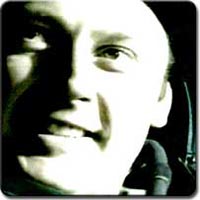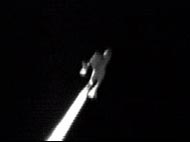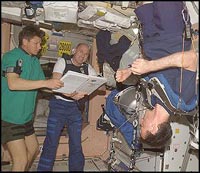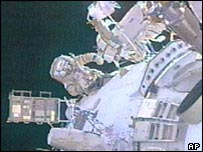| (insert your NIE or newspaper logo here) |
Weekly Online LessonOnline Lesson ArchiveGrade Level: 5-8
|
Life In Space
 The Expedition 9 crew landed safely on Earth, Saturday, October 23, 2004, as crew number 10 settled in for its six-month rotation at the International Space Station (ISS), orbiting 230 miles away.
The Expedition 9 crew landed safely on Earth, Saturday, October 23, 2004, as crew number 10 settled in for its six-month rotation at the International Space Station (ISS), orbiting 230 miles away.
November 2 will mark the ISS's fourth year in service — the same day that Expedition 10's Leroy Chiao will become the first American to cast his vote for president from space.
While Chiao's ballot will mark the expansion of democracy into space, a series of events over the last few weeks have marked the expansion of capitalism into space.
On October 4, a privately funded carrier successfully completed a second trip to "outer space" — considered to begin 100 km (62 miles) above the Earth's surface.
SpaceShipOne, developed by Mojave Aerospace Ventures, beat 19 other prototypes in the Ansari X Prize competition, and won $10 million.
The X Prize competition challenged entrepreneurs and rocket experts to be the first team to send a non-government craft into outer space, and repeat the feat in the same carrier within a two-week timeframe. The event was hosted at the Mojave Airport in southern California, which identifies itself as the world's first spaceport.
 The ultimate goal of the X Prize was to jumpstart the commercial space tourism industry. Until now, space flights have typically been government ventures, putting 433 people into space since 1957.
The ultimate goal of the X Prize was to jumpstart the commercial space tourism industry. Until now, space flights have typically been government ventures, putting 433 people into space since 1957.
Sir Richard Branson, president of Virgin Atlantic Airways, was so confident of the Mojave team's prototype after their first flight, that he signed an agreement with them in late September. The deal will allow Virgin to use SpaceShipOne's technology and build the world's first private spaceships.
The companies hope that within a few years, five Virgin Space Ships (VSS) will offer public space travel — three minutes of weightlessness and a once-in-a-lifetime view for about $185,000 — five passengers at a time.
This price tag is out of reach for most of Earth's residents, but just like computers and other evolving technologies, products often become more affordable for the masses over time.
Eventually, the development of commercial space travel and out-of-this-world hotels will make tourism and residential living beyond our home planet a reality.
To understand some of the challenges we face in successfully living off-world, this week you'll figure out how to design your own space station. Then you'll take a tour on the International Space Station to see what living there is really like, and how lessons learned on the ISS help pave the way for future space tourists.
Preparing for Space Life
 To live in space, people have to be able to meet their basic needs. These include eating, sleeping, exercising, and disposing of waste.
To live in space, people have to be able to meet their basic needs. These include eating, sleeping, exercising, and disposing of waste.
Let's explore how scientists have figured out how to meet these needs at CosmicQuest's Living in Space: Design a Space Station site. Click Let's Find Out!, read the introduction, then Let's Begin!
As you work through the activity, you'll discover how scientists had to solve the problem of maintaining a healthy environment for the space station's residents. In what ways must weight, storage space, and the crew's isolation be considered when figuring out how to supply the station's water, food, and other necessities?
Continue through your training program to prepare for Working in Space. Why is recycling water so important? How long does NASA require their astronauts to exercise every day? What would happen if they didn't?
Next, take the final challenge to design a self-sufficient space habitat. How has isolation from Earth's supply line affected the station's design and size? In what ways would living on the station be different than living on Earth? In what ways would they be similar?
On the ISS
 You get the general idea of how a space station operates, now let's visit the International Space Station to see how the theory compares to the reality of Living in Space. As you explore life on the station, make sure to watch some of the videos in each section.
You get the general idea of how a space station operates, now let's visit the International Space Station to see how the theory compares to the reality of Living in Space. As you explore life on the station, make sure to watch some of the videos in each section.
Check out the station's Space Food menu, what kind's of Space Wear to pack, and how to get some Space Sleep.
Space Work comes with its own challenges, of course, and there are times when the crew can have a little Space Fun. What has been the space station's primary purpose? Why is it important that the crew get time to relax and do things like disco-dancing?
Next, join a tour of the ISS as a Virtual Astronaut. Choose which version of the site you want to enter, then apply and sign-in to meet First Commander Bill Sheperd. Follow the training instructions to explore the station and all of the activities. To return to the main ISS menu after an activity, click the ISS icon in the top right corner.
 How does weightlessness affect bones and the various types of muscles? Why do these effects influence how and for how long someone can live in zero gravity? In what ways can tracking changes in the crew's health help future crew members?
How does weightlessness affect bones and the various types of muscles? Why do these effects influence how and for how long someone can live in zero gravity? In what ways can tracking changes in the crew's health help future crew members?
How will plant-growing experiments at the ISS help solve food supply problems for future station crews? As a space tourist, which sights might you be most interested in seeing? What would be most difficult to deal in living at the space station? What conditions would you hope to change first, before becoming a space tourist?
If you'd like to learn more about the ISS, check out other sections of the International Space Station site, or explore NASA's Humans in Space site, which includes more information on Preparing for Space Travel, Getting to Space, Living in Space, Working in Space, and Traveling in Space.
Newspaper Activities
Browse current issues of Targetnewspaper for stories about how the Expedition 9 crew is adapting to Earth-bound living after their six-month stay at ISS. How exactly are they readjusting to the planet's gravity? Did NASA doctors discover typical or unusual effects from living on the station? Also, watch for any news about how the Expedition 10 crew is getting along. Has life been routine, or has some kind of crisis arisen? Over the next few years, keep an eye out for news about the development of Virgin Space Ships and the future of space tourism.
© Copyright 2004
Learners
Online,
Inc.
